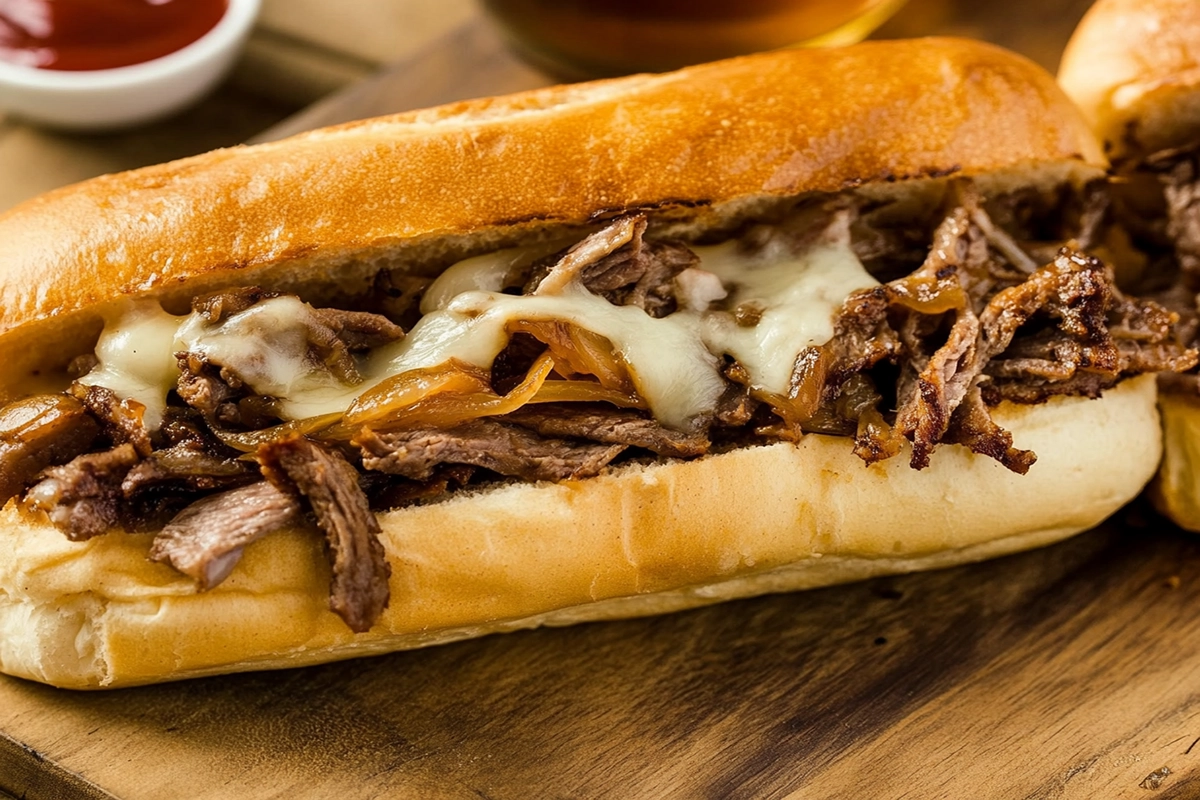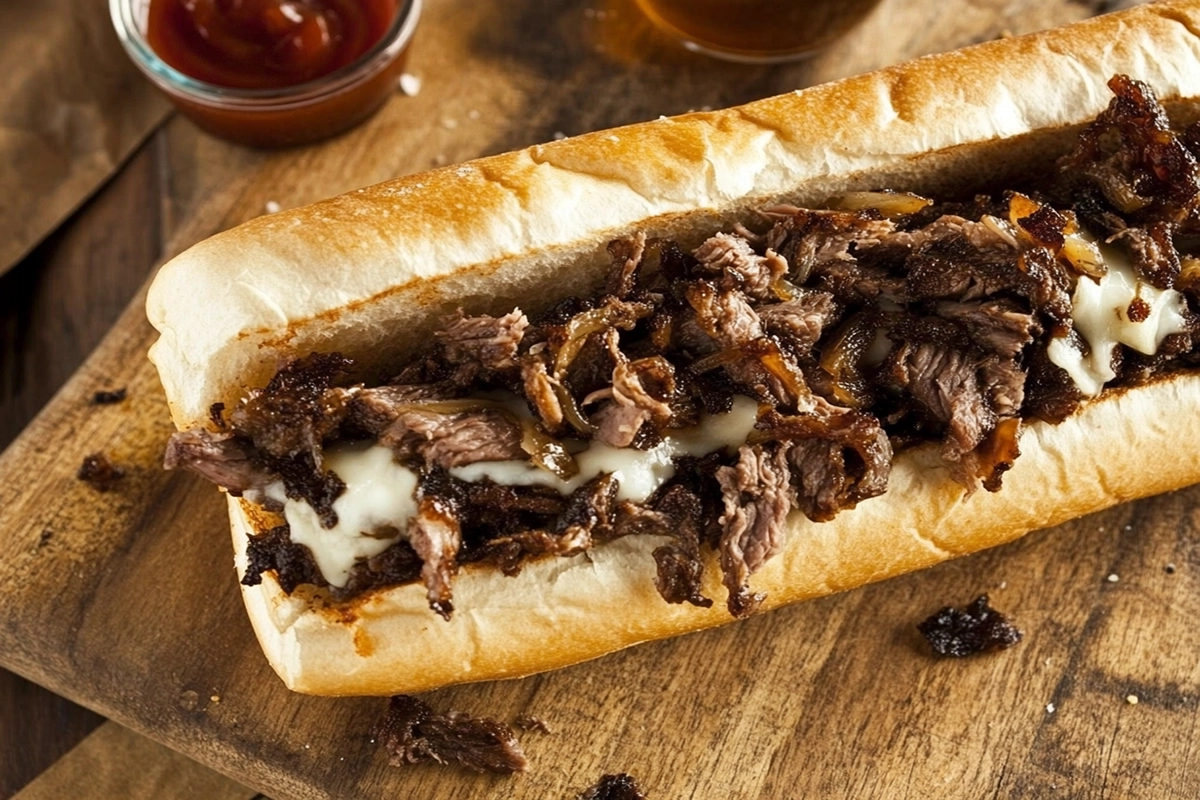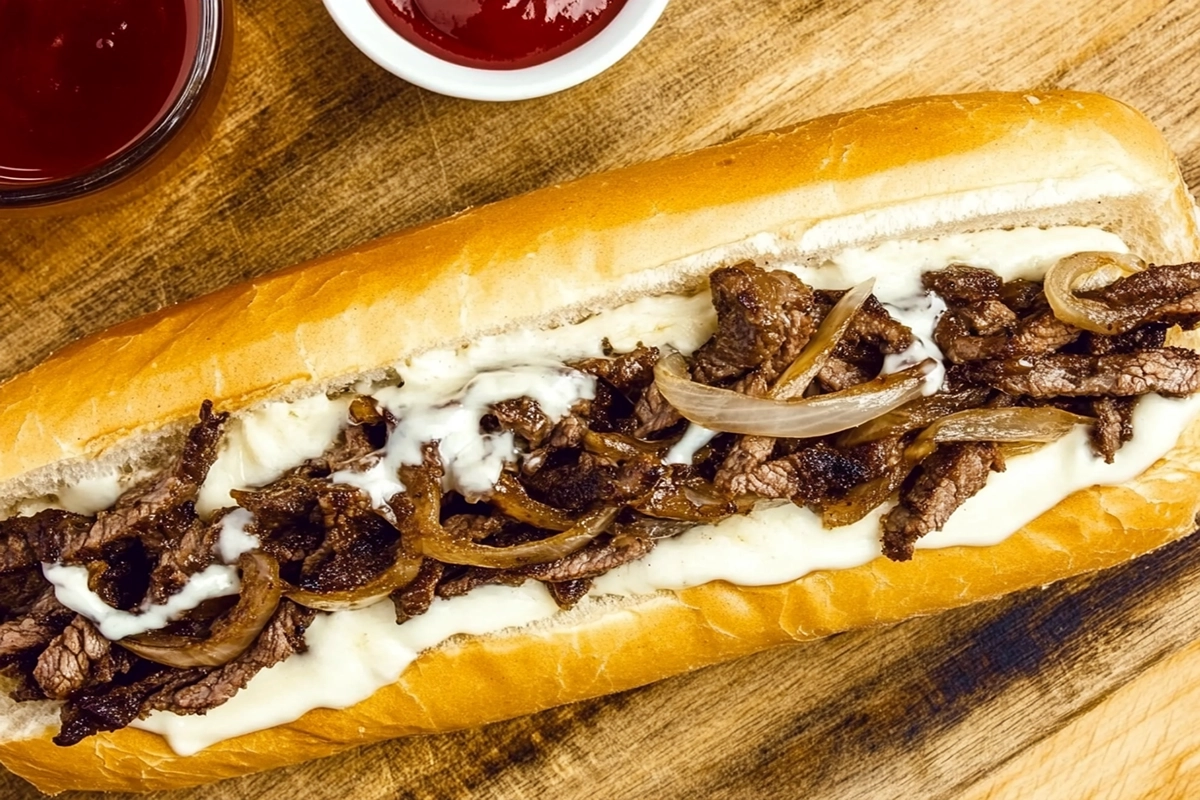Introduction to Philly Cheesesteak Roll Types
The Philly cheesesteak is one of the most iconic sandwiches in American cuisine, beloved for its simplicity and flavor. Originally hailing from Philadelphia, this sandwich is made with thinly sliced steak, melted cheese (usually provolone, Cheez Whiz, or American), and sautéed onions. However, one key element often overlooked is the Philly cheesesteak roll types. Choosing the right Philly cheesesteak roll type can transform an ordinary sandwich into something spectacular, making it a crucial component of the Philly cheesesteak roll experience.
In this article, we’ll explore the different types of rolls used for Philly cheesesteaks and how they contribute to the overall taste. For a twist on the classic sandwich, check out Philly Cheesesteak Tortellini Pasta as another way to enjoy these flavors. We’ll also explain why the bread is just as important as the fillings. Whether you’re making an authentic Philly cheesesteak at home or simply want to learn what makes this sandwich special, understanding the role of the roll is essential.
The Importance of the Roll in a Philly Cheesesteak
Many people think the steak and cheese are the stars of a Philly cheesesteak, but the roll is equally important. The roll holds all the ingredients together and absorbs the juices from the steak and cheese while maintaining its structure. Choosing the right Philly cheesesteak roll type ensures that the sandwich stays flavorful and enjoyable. The texture of the roll should complement the sandwich, providing a soft yet sturdy bite.
Why the Roll is Essential
- Texture Balance: The ideal cheesesteak roll offers the perfect balance between a soft, airy interior and a slightly crusty exterior. It must hold up to the juicy meat, melted cheese, and optional toppings without getting soggy.
- Absorption of Juices: The roll should soak up the savory juices from the steak and cheese while staying intact. A good cheesesteak roll will become slightly soft but never fall apart under the weight of its fillings.
- Proportion: A Philly cheesesteak roll is usually around 12 inches long, offering the right bread-to-filling ratio. If the roll is too small, it can overwhelm the sandwich; if it’s too big, it can dry out the sandwich.
Amoroso’s Bakery: The Classic Philly Cheesesteak Roll Type
For decades, Amoroso’s Bakery has been the go-to source for authentic Philly cheesesteak rolls. These rolls are known for their soft, chewy texture and light, thin crust. Moreover, they hold the fillings without becoming too heavy or soggy. In fact, many of Philadelphia’s famous cheesesteak shops, including Pat’s King of Steaks and Geno’s Steaks, have used Amoroso’s rolls for years. As a result, this has solidified the bakery’s reputation as the top choice for cheesesteak bread.
History and Evolution of Philly Cheesesteak Roll Types
The origin of the Philly cheesesteak goes back to the 1930s when Pat Olivieri, a hot dog vendor in South Philadelphia, decided to grill some thinly sliced beef for lunch. The aroma attracted nearby customers, and soon, the cheesesteak sandwich was born. As the sandwich gained popularity, local bakeries began creating rolls specifically designed to complement the sandwich.
The Creation of the Philly Cheesesteak Roll
The early versions of the cheesesteak sandwich were served on long Italian rolls. These rolls were soft on the inside with a crusty exterior, allowing them to hold up to the greasy, juicy steak without falling apart. As more people began enjoying the sandwich, the demand for a sturdier roll increased.
Bakeries like Amoroso’s and Sarcone’s Bakery rose to the challenge, creating hoagie rolls that were strong enough to withstand the juices but still soft enough to provide a pleasant eating experience. The balance between soft and sturdy is what makes these rolls perfect for cheesesteaks. The iconic rolls helped to define the Philly cheesesteak as we know it today.
Amoroso’s: The Gold Standard
When you think of a Philly cheesesteak, Amoroso’s rolls are often the first to come to mind. This Philadelphia-based bakery has been supplying rolls to local sandwich shops for over a century. Amoroso’s rolls are light, chewy, and have a slightly crisp crust—perfect for soaking up all the delicious juices from the steak and cheese.
Amoroso’s rolls are so beloved that many sandwich shops outside of Philadelphia have them shipped in to create an authentic Philly cheesesteak experience. The soft interior and thin crust are a hallmark of the Amoroso’s roll, making it the standard for many cheesesteak shops in Philadelphia.
The Rise of Seeded Rolls
While Amoroso’s remains the classic choice, other bakeries like Sarcone’s have gained popularity by offering seeded rolls. Sarcone’s seeded rolls add an extra layer of flavor and texture to the sandwich. The sesame seeds give the bread a slight crunch and a hint of nuttiness, providing a unique twist on the traditional cheesesteak roll.
Many cheesesteak aficionados believe that the sesame seeds enhance the flavor of the sandwich by adding a new dimension of texture. The crunchy exterior combined with the soft interior creates a satisfying bite, making seeded rolls a popular alternative to the classic Amoroso’s roll.
Philly Cheesesteak Roll Types Commonly Used
Several types of rolls are commonly used for Philly cheesesteaks, each offering a slightly different eating experience. The roll you choose can affect the flavor, texture, and overall enjoyment of the sandwich.
1. Amoroso’s Rolls
Amoroso’s rolls are the classic choice for a reason. Not only do they provide the perfect combination of soft and chewy, but they also have a thin crust that absorbs the steak’s juices without falling apart. As a result, these rolls are the gold standard in Philly cheesesteaks, used by many of the most famous sandwich shops in the city.
2. Sarcone’s Seeded Rolls
For those who enjoy a little extra texture and flavor in their bread, Sarcone’s seeded rolls offer an excellent alternative to the traditional hoagie roll. The sesame seeds add a crunchy, nutty flavor, while the bread itself is still soft enough to complement the sandwich’s fillings.
3. Liscio’s Rolls
Liscio’s Bakery is another popular option in Philadelphia. Their rolls vary in texture, from soft to slightly crispy, depending on the shop’s preference. Some cheesesteak shops opt for the soft version, while others prefer a roll with a bit more bite.
4. Seeded vs. Seedless Rolls
When choosing between a seeded or seedless roll, it’s a matter of personal preference. Seeded rolls provide a slightly more flavorful and crunchy experience, while seedless rolls allow the steak and cheese to shine without added texture.
What Makes the Perfect Cheesesteak Roll?
The perfect cheesesteak roll must strike a balance between softness and sturdiness. It needs to absorb the juices from the steak and cheese without becoming soggy, while still providing a satisfying bite. Several factors contribute to making the ideal roll:
Texture: Soft vs. Sturdy Rolls
- Soft Interior: The inside of the roll should be soft and fluffy, allowing it to soak up the juices from the steak and cheese.
- Sturdy Exterior: The exterior of the roll should have just enough crust to hold the sandwich together without being too hard or crunchy. The crust should add structure, not interfere with the softness of the interior.
Absorbing Juices Without Getting Soggy
One of the most important characteristics of a cheesesteak roll is its ability to absorb the juices from the steak and cheese without becoming soggy. The best rolls, like those from Amoroso’s, can soak up the flavors without losing their shape or integrity.
Length and Size of the Roll
The typical Philly cheesesteak roll is 12 inches long, providing enough space to hold the steak, cheese, and any additional toppings. The size of the roll is critical in maintaining the sandwich’s balance, ensuring that the bread doesn’t overwhelm the fillings.
Baking Process for Different Philly Cheesesteak Roll Types
Baking Techniques for Philly Cheesesteak Rolls
Cheesesteak rolls are usually baked fresh daily in local bakeries across Philadelphia. The secret to a perfect cheesesteak roll lies in the baking process. Rolls baked with high-quality ingredients, such as those from Sarcone’s and Amoroso’s, have the perfect balance of crustiness and softness.
The Role of Sesame Seeds in Baking
For those who enjoy seeded rolls, the baking process often involves adding sesame seeds before baking. The seeds are baked into the crust, giving the roll an extra layer of flavor and a crunchy texture. Seeded rolls are typically a favorite among those looking for a unique take on the traditional cheesesteak.
FAQs About Rolls for Philly Cheesesteaks
What type of bread is best for a Philly cheesesteak?
The best bread for a Philly cheesesteak is a soft hoagie roll or Italian roll. The most iconic choice is Amoroso’s roll, which offers the perfect balance of soft interior and sturdy crust.
Can I use any type of roll for a cheesesteak?
While you technically can use any long roll, an authentic Philly cheesesteak is made with a hoagie roll that absorbs the juices while holding its shape. The best rolls come from Philadelphia bakeries like Amoroso’s and Sarcone’s.
What are the advantages of seeded rolls for cheesesteaks?
Seeded rolls offer a slight crunch and nutty flavor from the sesame seeds, which many cheesesteak fans enjoy. They add extra texture and flavor without overpowering the steak and cheese.
Do cheesesteak rolls need to be toasted?
Toasting is optional. However, it can help prevent the roll from becoming soggy, especially when the sandwich contains juicy ingredients like steak and melted cheese.
Conclusion
The roll used in a Philly cheesesteak is just as important as the steak and cheese. A high-quality roll, such as those from Amoroso’s or Sarcone’s, ensures the sandwich stays flavorful and satisfying from the first bite to the last. Whether you prefer a soft, chewy roll or a crunchy seeded one, the bread plays a key role. It helps create the perfect Philly cheesesteak experience.
Next time you’re enjoying a Philly cheesesteak, make sure to take a moment to appreciate the role of the roll. After all, it’s the foundation that holds everything together and can even elevate a good sandwich into something truly special. If you’re interested in learning more, check out this Wikipedia article for insights into the science behind Philly cheesesteaks.



